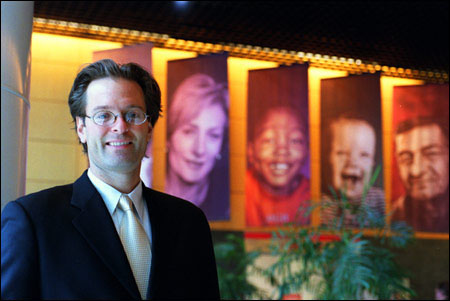Laughing it up in therapy
It can be seriously contagious

Did you hear the one about the psychiatrist who laughs during therapy? Humor was once considered taboo at such times because it might disrupt a patient’s chain of thought or hurt his or her feelings. But analysis of videotapes of 10 recent sessions reveals that psychotherapy can be a laughing matter.
However, the videos also show that the giggles, chuckles, and chortles are less about humor and more about communicating emotion. And a lot of it went on. An average of 15 laughs occurred in each of the 50-minute sessions, which included 10 different patients and therapists.
“I was surprised at the amount of laughter,” admits Carl Marci, the researcher who led the study at Massachusetts General Hospital (MGH). “This was the first objective study of the role of laughter during psychotherapy, and we found that patients use it to communicate emotion, to express things their words do not. Many therapists have been caught up in the old notion that laughter only signifies humor, and have questioned whether using it in therapy is appropriate. We think it is.”
The psychiatrists didn’t laugh as much as the patients, who were being treated for mood disorders such as depression and anxiety. In fact, patients laughed more than twice as often as the therapists, but that doesn’t mean that their doctors were not involved with their emotions.
Both patients and psychiatrists were hooked up to lie-detector-type devices that measure skin conductance, or sweating. Skin conductance rises with increases in the nervous system activity that also controls blood pressure and heart rate. The rise signifies increased arousal.
The psychiatrists didn’t always laugh with their patients, but their skin response indicates that they shared their arousal. When the two laughed together, arousal was higher than when one laughed alone.
“This contagion of laughter suggests that the patients feel the emotions they are expressing are validated,” says Marci, who is director of Social Neuroscience in MGH’s Department of Psychiatry, and an instructor at the Harvard Medical School. “It supports the notion of empathy as a shared experience.”
What it means
Does this mean that mirth can improve therapy and so a person’s mental health? Marci won’t go that far. “Our study was not designed to answer such a sweeping question,” he says. “The important result is the finding that a laughing patient is trying to say more than he or she is expressing verbally. That tells us that we have to pay closer attention to when patients laugh, specifically what is said just before laughter begins.”
To get a tighter handle on what chuckling does for a person and how it might help in treating various mental disorders, Marci and his colleagues have started a larger study to track how laughter and emotions change as therapy proceeds. This should reveal if there is a significant relationship between apparent merriment and mental health.
There is the possibility that laughter could be used as a measure of how well the therapy is going. An increase in hilarity might not always mean progress, since most of the chortling stems from nervousness, not joy. Therefore, less mirth would be appropriate for patients suffering from anxiety. On the other hand, more mirth could signal an improvement in certain depressed patients.
Either way, people can’t hide their emotions behind a laugh the way they can hide behind a smile, Marci believes. “There’s evidence that laughter is a uniquely human activity. Chimps and other apes do not laugh the way we do. This suggests that laughter evolved in humans as a means of emotional communication to foster alliance formation and social unity.”
Other researchers find that laughs are significantly more likely to elicit positive responses than grunts or pants.
There’s also a sex angle. Another study concluded that men generate more hilarity in mixed audiences than women. Females chuckle more in response to male versus female speakers. Such increased female amusement is associated with increased interest in the speaker, according to the researchers.
These differences were not picked up in Marci’s research because males and females were not specifically matched, and the study was small. Patients included five women and five men, ages 18 to 65. Seven male and three female therapists participated.
The experiment, together with some interesting background material on laughter research, is described in the October issue of The Journal of Nervous and Mental Disease. Erin Moran and Scott Orr of MGH and Harvard Medical School are co-authors.
All psychiatrists go through therapy as part of their training. Marci showed me a video clip of himself as the patient. Yes, he laughed a lot, more than his therapist. Yes, he said, he was nervous.




